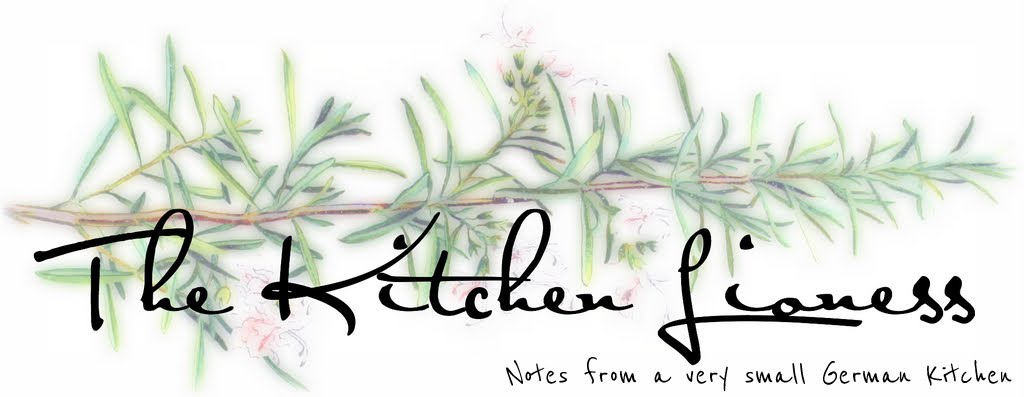Snow white Elderflower Ice Cream tastes wonderfully tangy, aromatic,
refreshing, and calls for only seven ingredients. For this ice cream you
will need some Elderflower Cordial either homemade or store bought. You don't
even have to go and pick your own elderflower as a good quality Elderflower
Cordial will work just fine. This way, if you do not have access to
Elderflowers or if the season has come to an end, you will still be able to
enjoy this elegant ice cream.
As one of the ingredients, I use “Skyr”, a milk product from Iceland that is a soft cheese but is similar to yogurt, has gained immense popularity in many countries in recent years and is readily available at most supermarkets – it is tangy and a good source of calcium and together with the sour cream (Schmandt) and cooking cream, lends a nice creaminess to the ice cream.
I think that the warm Waffle Cones go very well with my Elderflower Ice Cream but you could serve your ice cream just as is or with fresh seasonal berries.
After the ice cream has happily churned away in the ice cream maker for about 45 minutes, and then been in the freezer for a few hours (about 4), I start making the waffle cones - no need for the waffle batter to rest, they can be baked right away, it takes all of ten minutes to get the batter ready. While I make the waffle cones, the ice cream stays in the freezer and I take it out just before serving – if you decide to make the ice cream the day before you plan to serve it, you will notice that it is quite firm, so make sure to take it out of the freezer and let it sit at room temperature for 10 to 15 minutes (or a bit less or more, depending on the weather conditions).
To make my Elderflower Ice Cream, I use Elderflower Cordial to add the flavor, rather than fresh elderflowers, which means that you can make this recipe at any time of the year. However, for me, this is an early summer recipe. Every year, I make my own home-made Elderflower Cordial. However, there are lots of great quality ready-made versions available in supermarkets, farmers markets and health food stores that will be perfect for using in this recipe.
Elderflower Ice Cream
Ingredients
- 200g Skyr, plain
- 150g heavy sour cream (20%)
- 60g cooking cream
- 100g elderflower syrup (either use homemade or a good quality store bought one)
- 60g sugar
- a pinch of fine salt
- ½ tsp carob bean gum, organic (a natural stabilizer, available at your local health food store OR online)
Preparation
- Mix all the ingredients together.
- Freeze in your ice cream maker (I let it churn for about 45 minutes).
- Transfer the ice cream to a suitable container and freeze for a few hours until it has the desired consistency.
Waffle Cones
Ingredients
(for 8 cones)
- ¾ cups white spelt flour OR use AP (plain) flour
- ¼ tsp fine salt
- ¼ tsp Ceylon cinnamon
- ¾ cup plus 2 tbsp powdered sugar, divided
- 3 egg whites (L), free-range or organic
- 5 tbsp (70g) unsalted butter, melted
Special Equipment
- A waffle-cone maker
Preparation
- Whisk flour, salt, cinnamon, and ¾ cup powdered sugar in a medium bowl.
- Using an electric mixer on medium-high speed, beat egg whites and remaining 2 Tbsp. powdered sugar in a large bowl to stiff, fluffy peaks.
- Fold dry ingredients into egg white mixture until just blended.
- Fold in butter and mix until all is incorporated.
- Spray a waffle-cone maker with nonstick spray and heat to medium.
- Using ¼ cup (60ml) batter per batch, make waffle cones one at a time and according to manufacturer’s instructions, baking to desired doneness and molding them while still warm.
Holunderblüten Eis
Zutaten
- 200g Skyr, Natur
- 150g Schmand/ Sauerrahm (20%)
- 60g Sahne
- 100g Holunderblüten Sirup (selbstgemacht oder gekauft, dann am besten Bio-Qualität)
- 60g Zucker
- eine Prise Salz
- ½ TL Johannisbrotkernmehl (gibt es im Bio-Markt)
Zubereitung
- Alle Zutaten mit dem Mixer gut und glatt verrühren.
- In der Eismaschine nach Bedienungsanleitung gefrieren (bei mir zirka 45 Minuten).
- Das Eis in einen Kunststoffbehälter geben, gut verschließen und wenigstens vier Stunden (oder mehr) im Tiefkühler fest werden lassen.
Eiswaffeln
Zutaten
(für 8 Waffeln )
- 100g helles Dinkelmehl Type 630 ODER Weizenmehl
- TL feines Salz
- ¼ TL Ceylon Zimt
- 75g plus 2 EL Puderzucker, geteilt
- 3 Eiweiße (L), Freilandhaltung oder Bio
- 5 EL (70g) ungesalzene Butter, geschmolzen
Spezialausrüstung
- Ein Waffel-Hörnchen Eisen
Zubereitung
- Mehl, Salz, Zimt und 75g Puderzucker in einer mittelgroßen Schüssel verrühren.
- Mit einem elektrischen Handmixer Eiweiß und verbleibende 2 EL Puderzucker in einer großen Schüssel zu steifem Schnee schlagen.
- Die Mehlmischung in die Eiweißmischung falten, bis sie gerade vermischt sind.
- Die geschmolzene Butter unter den Teig heben und mischen, bis alles eingearbeitet ist.
- Ein Waffel-Hörnchen Eisen vorheizen und entweder mit Antihaft-Spray etwas einsprühen ODER mit wenig Fett auswischen.
- Die Waffeln nacheinander backen und während sie noch warm sind, zu Waffelhörnchen aufdrehen.
For more Waffle Roll recipes, go to:
- Lemon Waffle Rolls (Zitronen Waffelröllchen) (HERE)
- Speculaas Waffle Rolls (Spekulatius Eiserkuchen) (HERE)
- New Year’s Waffles (Neujahrswaffeln) (HERE)
For more seasonal Elderflower recipes, go to:
- Elderflower Bread (Holunderblüten Brot) (HERE)
- Elderflower Cake with Strawberry-Elderflower Filling and Elderflower Icing & Elderflower Cordial (Holunderblüten Kuchen mit Erdbeer-Holunderblüten Füllung und Holunderblüten Sirup) (HERE)
- Elderflower Fritters (Ausgebackene Holunderblüten) (HERE)
- Elderflower Shortbread (Holunderblüten Shortbread) (HERE)


